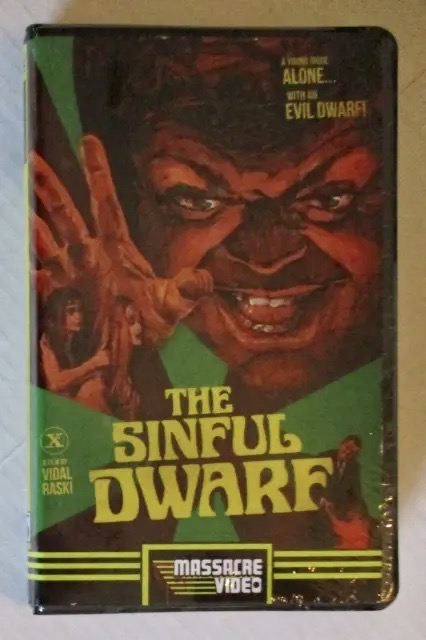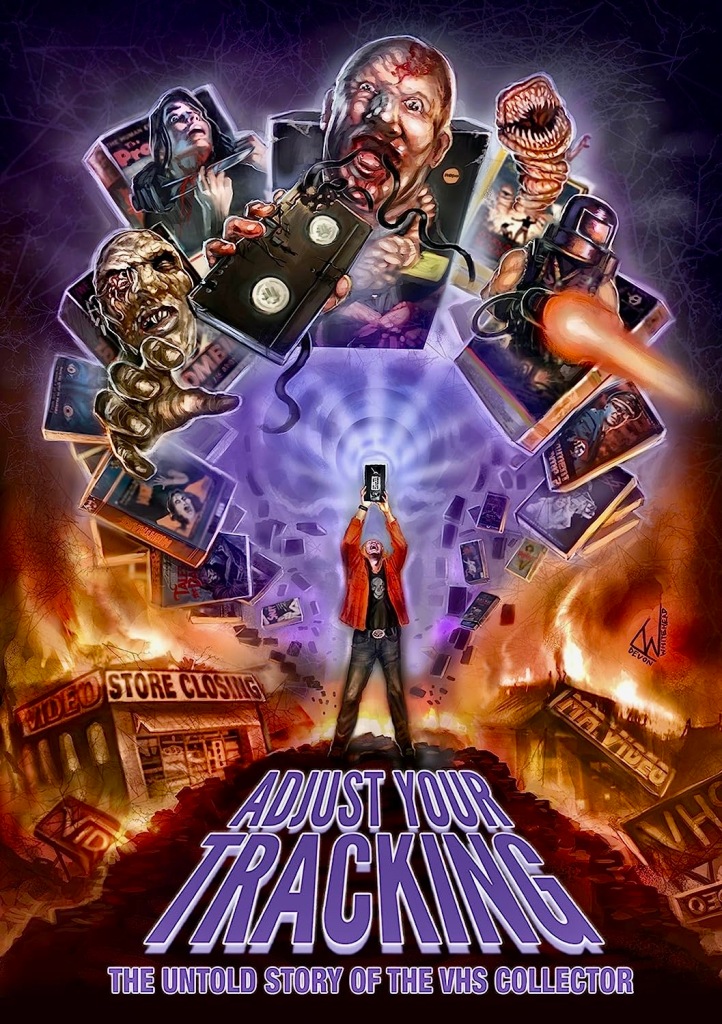Fantagraphics Books, which was founded in 1976 by Gary Groth and Michael Catron, has always been one of the most creative and unique publishers of graphic novels, manga, comic strip anthologies and alternative comics like the Hernandez brothers’ Love and Rockets and Jay Disbrow’s The Flames of Gyro. The focus of the company has always been comics and graphic art but occasionally a one-of-a-kind anomaly will pop up in their release schedule such as Portable Grindhouse: The Lost Art of the VHS Box by Jacques Boyreau, which first appeared in their Fall 2009 catalog. With its oversized VHS box design complete with slipcase and fetishized detail, right down to the FBI warning and reminder to “Keep out of direct sunlight,” Portable Grindhouse is a must-have collectible for any movie buff.
This is much more than a one-trick gimmick book. It is a loving homage to a brief period in our technological past when VCRs and VHS revolutionized the way we watched movies but also offered us choices we never dreamed possible prior to the eighties. Before the dawn of the VCR, some of us remember the challenge of staying up till 3 am to watch a movie we always wanted to see on television or the thrill of seeking out some drive-in or seedy movie theatre where renegade and non-mainstream movies like Tanya’s Island (1980), The Sinful Dwarf (1973) or The Crippled Masters (1979) received brief runs. The VHS craze changed all that and suddenly gave us access to an endless video candy store. It also spoiled us in some ways, often killing the mystique of hunting down the must-see titles on our holy grail list.
More often though, the VHS rental phenomenon allowed me to explore various genres, especially Eurotrash and obscure international cinema, as well as catch up on the back catalog of specific directors like Pier Paolo Pasolini, Doris Wishman, Jamaa Fanaka, Stephanie Rothman or Matt Cimber. Back when almost every major consumer outlet from Best Buys to Wal-Mart to your local drug store had a VHS section that sold and rented them, it was fun to browse the rows of selections, looking for gems and oddities. Often the best part was just looking at the VHS box or clamshell design which often overdelivered on the promise of what was inside but that was a large part of the appeal. Even better was exploring the smaller independent chains and local mom & pop rental stores where you never knew what lost treasures may be awaiting you.
Portable Grindhouse: The Lost Art of the VHS Box perfectly captures the trashy allure and pioneering spirit of the early VHS market with its strong emphasis on exploitation films. Boyreau not only gets into some of the geekboy speak about the technical aspects of the format that readers like me used to expect of Video Watchdog and similar publications but also puts the VHS rental and collectible world into context, allowing us to see why- in some ways – it was more fun than DVD and definitely more wide-ranging and democratic in what it offered the consumer in choices
Boyreau hits the nail on the head when he states, “What VHS created was the ability to hold a movie in your hand and feel its power. Film consumption is not film possession. A movie is a running out, a mechanized going-until-gone, and that great fleetingness subconsciously stokes a desire to possess this thing, and that’s what video really accomplished: it turned movies into things, into sentimental totems in which VHS binds a clinging to the whole of a movie, where movie-magic is purloined by tape and by box….Posters could advertise, slightly fetishize a movie; credit sequences could identify participants; but with conspicuous street cred and hustler-friendly mercantilism, VHS box-art ‘became’ the iconic equivalent of the movie.”
According to the entry on VHS in Wikipedia, “The final major Hollywood motion picture released on VHS was David Cronenberg’s A History of Violence” [released in 2005], which seems so appropriate when you consider that Cronenberg made the ultimate visionary film about VHS/media consumption – Videodrome (1983). The Criterion Collection DVD release of it also predicted the book jacket design of Portable Grindhouse with its more realistically scaled VHS shape and “fake” spine and visible drumrolls; a nice extra touch was the Rec Mode sticker bearing the handwritten label: Long Live The New Flesh.
Below are some samples from Portable Grindhouse while others are some of my favorite examples of this now lost VHS art form which was predominately male oriented, a telling example of the times and the industry. Some of these images will conjure up now defunct distributors while others may remind you that it was not uncommon for some titles to enjoy an entirely new life on VHS under a new name – and, in the case of international films, often re-dubbed and re-edited into something entirely different than its original version such as Screamers (1978), an Italian horror/fantasy starring Barbara Bach and Joseph Cotton, which also exists under the titles Isle of the Fisherman, Island of Mutations and Something Waits in the Dark.
Fantagraphics’ Portable Grindhouse also includes examples of some of the weirder “How To” videos (Bowhunting Whitetails: Just for Fun), sports docs (Greatest Sports Legends: Johnny Bench), educational fare (Gary Coleman: For Safety Sake), TV specials (Schwarzkopf: How the War Was Won), and even big budget releases such as Streets of Fire (1984) and Network (1976).
One genre that really flourished during the VHS era was martial arts movies. Not only could you peruse countless Shaw Brothers productions, Bruce Lee imitators and other Chinese/English dubbed concoctions but you also had a huge choice of homegrown American variations and European hybrids featuring such stars as Chuck Norris, Jean-Claude Van Damme, Cynthia Rothrock and Don “The Dragon” Wilson.
VHS was also the dumping ground for the most unwatchable direct-to-video movies ever made (almost anything from Raedon – Punk Vacation, Nudity Required, etc.) as well as low-budget indie horror pics like Flesh Feast (1970), a mind-numbing melange of Veronica Lake, Hitler and flesh-eating maggots, and Brain of Blood, a hilariously bad 1972 monstrosity from director Al Adamson starring Grant Williams (The Incredible Shrinking Man), Kent Taylor (The Day Mars Invaded Earth) and Angelo Rossitto (Freaks). I like how the VHS repackaging puts a new spin on a famous George W. Bush axiom: “Because….a brain is a terrible thing to waste!”
Oddball one-offs like The Lift (1983) and Pin (1988) would present a distribution challenge to the most creative marketeer but somehow the promotional campaigns made these films more intriguing to collectors of arcane cinema. A killer elevator is an amusing idea for a film but at 99 minutes this Dutch fantasy/horror becomes tedious and repetitive despite stylish art direction and a few memorable moments. The box art is great though depicting a man with his head caught in the elevator doors and the caption: “Take the stairs, Take the stairs, For God’s Sake, Take the stairs!”
Pin, on the other hand, is one of those little discoveries that made VHS store browsing worthwhile. An unheralded indie film from Canada, this psychodrama-creepshow about a man’s obsession/relationship with a life size, anatomically correct dummy named Pin is an absorbing character study that doesn’t easily fit into any genre. Directed by Sandor Stern, who authored The Amityville Horror screenplay and subsequently moved into television features, the movie features strong performances by David Hewlett as the disturbed Leon, Cynthia Preston as his concerned sister Ursula and Terry O’Quinn (The Stepfather) as Leon’s psychiatrist.
Among some of my favorite retitlings are The Witching (original title: Necromancy), Bert I. Gordon’s 1972 supernatural dud starring Pamela Franklin and Michael Ontkean with Orson Welles as the head of a witch coven, sporting his most unconvincing fake nose; Kiss Me Kill Me (original title: Baba Yaga), a 1973 S&M pop art fantasy with Carroll Baker seducing photographer Isabelle De Funes through black magic; Death Weekend (aka The House by the Lake, 1976), a thoroughly unpleasant yet compelling rape/revenge thriller in which Brenda Vaccaro is terrorized by Don Stroud and his moronic sidekicks; Circle of Power (aka Mystique, Brainwash and The Naked Weekend), a sleazy but surprisingly engrossing 1983 melodrama of a company retreat/training session gone wrong with Yvette Mimieux as a corporate dominatrix subjecting employees to humiliating acts, Terror Circus (also known as Barn of the Naked Dead and Nightmare Circus), a rare 1974 venture into exploitation cinema by Robert Altman protege Alan Rudolph starring Andrew Prine as a psycho who kidnaps woman and makes them perform in his perverse private circus. He also has a radioactive mutant for a father that he keeps locked in a shed….and of course, the monster gets out, creating bloody mayhem.
Anyone who misses the days when VHS was king will get a huge kick out of Portable Grindhouse. And there have been other forms of media on the subject since this Fantagraphics 2009 release such as the 2019 documentary, Adjust Your Tracking: The Untold Story of the VHS Collector by Dan M. Kinem and Levi Peretic.
Other links of interest:
https://www.fantagraphics.com/
https://www.theguardian.com/artanddesign/2015/jul/10/vhs-video-cover-art-revival
https://dangerousminds.net/comments/lost_art_of_the_lurid_vhs_cover
https://www.tohokingdom.com/articles/art_boxart_1990-2000.htm















